oracle 1Z0-1085-21 Exam Questions
Questions for the 1Z0-1085-21 were updated on : Jul 20 ,2024
Page 1 out of 7. Viewing questions 1-15 out of 99
Question 1
A company has developed an eCommerce web application In Oracle Cloud Infrastructure.
What should they do to ensure that the application has the highest level of resilience?
- A. Twitter notifications
- A. Deploy the application across multiple Regions and Availability Domains.
- B. Text Message notifications
- B. Deploy the application across multiple Availability Domains and subnet.
- C. Email notifications
- C. Deploy the application across multiple Virtual Cloud Networks.
- D. Webhook notifications
- D. Deploy the application across multiple Availability Domains and Fault Domains.
Answer:
A
Explanation:
For highest level of resilience you can deploy the application between regions and distribute on
availability domain and fault domains.
Reference:
https://www.oracle.com/cloud/iaas/faq.html
Question 2
You have a mission-critical application which requires to be globally available at all times.
Which deployment strategy should you adopt?
- A. Only scaling up or down
- A. Use multiple Fault Domains In each Availability Domain in each Region.
- B. Only scaling out
- B. Use multiple Availability Domains In one Region.
- C. Scaling up or down, and scaling in or out
- C. Use multiple Fault Domains In one Region.
- D. Only scaling in
- D. Use multiple Fault Domains in any Availability Domain in multiple Regions.
Answer:
A
Explanation:
Oracle Cloud Infrastructure is hosted in regions and availability domains. A region is a localized
geographic area, and an availability domain is one or more data centers located within a region. A
region is composed of one or more availability domains.
Regions are independent of other regions and can be separated by vast distancesacross countries
or even continents.
Availability domains are isolated from each other, fault tolerant, and very unlikely to fail
simultaneously. Because availability domains do not share infrastructure such as power or cooling, or
the internal availability domain network, a failure at one availability domain within a region is
unlikely to impact the availability of the others within the same region.
Fault domain is a grouping of hardware and infrastructure within an availability domain. Each
availability domain contains three fault domains. Fault domains provide anti-affinity: they let you
distribute your instances so that the instances are not on the same physical hardware within a single
availability domain. A hardware failure or Compute hardware maintenance event that affects one
fault domain does not affect instances in other fault domains. In addition, the physical hardware in a
fault domain has independent and redundant power supplies, which prevents a failure in the power
supply hardware within one fault domain from affecting other fault domains.
Reference:
https://docs.cloud.oracle.com/en-us/iaas/Content/General/Concepts/regions.htm
Question 3
Which Oracle Cloud Infrastructure service allows you to run code without provisioning any
underlying infrastructure resources?
- A. Filter costs by applications
- A. Compute service
- B. Filter costs by tags
- B. Storage Gateway
- C. Filter costs by compartments
- C. Oracle Container Engine for Kubernetes
- D. Filter costs by date
- D. Oracle Functions
Answer:
D
Explanation:
Oracle Functions is a fully managed, multi-tenant, highly scalable, on-demand, Functions-as-a-
Service platform. It is built on enterprise-grade Oracle Cloud Infrastructure and powered by the Fn
Project open source engine. Use Oracle Functions (sometimes abbreviated to just Functions) when
you want to focus on writing code to meet business needs.
Theserverlessandelasticarchitecture of Oracle Functions means there's no infrastructure
administration or software administration for you to perform. You don't provision or maintain
compute instances, and operating system software patches and upgrades are applied automatically.
Oracle Functions simply ensures your app is highly-available, scalable, secure, and monitored. With
Oracle Functions, you can write code in Java, Python, Node, Go, and Ruby (and for advanced use
cases, bring your own Dockerfile, and Graal VM). You can then deploy your code, call it directly or
trigger it in response to events, and get billed only for the resources consumed during the execution.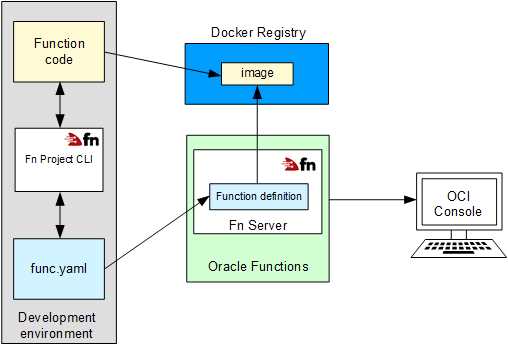
Reference:
https://docs.cloud.oracle.com/en-
us/iaas/Content/Functions/Concepts/functionsoverview.htm
Question 4
Which three methods can you use to create or modify Oracle Cloud Infrastructure (OCI) resources?
- A. When you stop a compute instance, all data on the boot volume islost
- A. REST APIs
- B. You can attach a maximum of one public to each compute instance
- B. OCI desktop client
- C. You can launch either virtual machines or bare metal instances
- C. Secure Shell (SSH)
- D. You cannot attach a block volume to a compute instance
- D. OCI Console
- E. Command-line Interface
- F. Remote Desktop Protocol (RDP)
- G. Serial console connection
Answer:
A, D, E
Explanation:
You can create and manage resources in the following ways:
Oracle
Cloud
Infrastructure
Console
The Console is an intuitive, graphical interface that lets you create and manage your instances, cloud
networks, and storage volumes, as well as your users and permissions. See
Using the Console
.
Oracle
Cloud
Infrastructure
APIs
The Oracle Cloud Infrastructure APIs are typical REST APIs that use HTTPS requests and responses.
See
API Requests
.
SDKs
Several Software Development Kits are available for easy integration with the Oracle Cloud
Infrastructure APIs, including SDKs for Java, Ruby, and Python. For more information, see
Developer
Resources
.
Command
Line
Interface
(CLI)
You can use a command line interface with some services. For more information, see
Developer
Resources
.
Terraform
Oracle supports Terraform. Terraform is "infrastructure-as-code" software that allows you to define
your infrastructure resources in files that you can persist, version, and share. For more information,
see
Getting Started with the Terraform Provider
.
Ansible
Oracle supports the use of Ansible for cloud infrastructure provisioning, orchestration, and
configuration management. Ansible allows you to automate configuring and provisioning your cloud
infrastructure, deploying and updating software assets, and orchestrating your complex operational
processes. For more information, see
Getting Started with Ansible for Oracle Cloud Infrastructure
.
Resource
Manager
Resource Manager is an Oracle Cloud Infrastructure service that allows you to automate the process
of provisioning your Oracle Cloud Infrastructure resources. It helps you install, configure, and manage
resources using the "infrastructure-as-code" model. For more information, see
Overview of Resource
Manager
.
Reference:
https://docs.cloud.oracle.com/en-us/iaas/pdf/gsg/OCI_Getting_Started.pdf
Question 5
Which CANNOT be used with My Oracle Support (MOS)?
- A. Each Availability Domain has a single Fault Domain.
- A. Add or change a tenancy administrator
- B. Each Availability Domain has three Fault Domains.
- B. Request a Service Limit increase
- C. Each Fault Domain has multiple Availability Domains.
- C. Reset the password or unlock the account for the tenancy administrator
- D. Each region has a single Fault Domain.
- D. Troubleshoot your resources in an Oracle Cloud Infrastructure Free Trial account
Answer:
D
Explanation:
Open a support service request with MOS option is available to paid accounts. Customers using only
Always Free resources are not eligible for Oracle Support. Limited support is available to Free Tier
accounts with Free Trial credits. After you use all of your credits or after your trial period ends
(whichever comes first), you must upgrade to a paid account to access Oracle Support. If you choose
not to upgrade and continue to use Always Free Services, you will not be eligible to raise a service
request in My Oracle Support.
In addition to support for technical issues, use
My Oracle Support
if you need to:
Reset the password or unlock the account for the tenancy administrator
Add or change a tenancy administrator
Request a
service limit
increase
Reference:
https://docs.cloud.oracle.com/en-us/iaas/Content/GSG/Tasks/contactingsupport.htm
Question 6
Which is a key benefit of using oracle cloud infrastructure autonomous data warehouse?
- A. NAT Gateway
- A. No username and password required
- B. Service Gateway
- B. Scale both CPU and Storage without downtime
- C. Dynamic Routing Gateway
- C. Apply database patches as they become available
- D. Internet Gateway
- D. Maintain root level acress to the underlying operating system
Answer:
B
Explanation:
Oracle Autonomous Data Warehouse is a cloud data warehouse service thateliminatesvirtually all
the complexities of operating a data warehouse and securing data. It automates provisioning,
configuring, securing, tuning, scaling, patching, backing up, and repairing of the data warehouse.
Unlike other fully managed cloud data warehouse solutions that only patch and update the
service,it also featureselastic, automated scaling, performance tuning, security, and a broad set of
built-in capabilities that enable machine learning analysis, simple data loading, and data
visualizations.
Data Warehouse uses continuous query optimization, table indexing, data summaries, and auto-
tuning to ensure consistent high performance even as data volume and number of users grows.
Autonomous scaling can temporarily increase compute and I/O by a factor of three to maintain
performance.Unlike other cloud services which require downtime to scale, Autonomous Data
Warehouse scales while the service continues to run.
Reference:
https://www.oracle.com/autonomous-database/autonomous-data-warehouse/
Question 7
Which three components are part of Oracle Cloud Infrastructure (OCI) identity and access
management service?
- A. Providing Fault tolerance
- A. Regional Subnets
- B. Adding additional compute instances
- B. Policies
- C. Enabling Disaster recovery
- C. Users
- D. Changing to a large or smaller shape
- D. Compute Instances
- E. Dynamic Groups
- F. Roles
- G. Virtual Cloud Networks
Answer:
B, C, E
Explanation:
Components ofIAM
IAMuses the components described in this section. To better understand how the components fit
together, see
Example Scenario
.
RESOURCE
The cloud objects that your company's employees create and use when interacting withOracle Cloud
Infrastructure. For example: compute instances, block storage volumes, virtual cloud networks
(VCNs), subnets, route tables, etc.
USER
An individual employee or system that needs to manage or use your company'sOracle Cloud
Infrastructureresources. Users might need to launch instances, manage remote disks, work with
your virtual cloud network, etc. End users of your application are not typicallyIAMusers. Users have
one or moreIAMcredentials (see
User Credentials
).
GROUP
A collection of users who all need the same type of access to a particular set of resources or
compartment.
DYNAMIC GROUP
A special type of group that contains resources (such as compute instances) that match rules that you
define (thus the membership can change dynamically as matching resources are created or deleted).
These instances act as "principal" actors and can make API calls to services according to policies that
you write for the dynamic group.
NETWORK SOURCE
A group of IP addresses that are allowed to access resources in your tenancy. The IP addresses can be
public IP addresses or IP addresses from a VCN within your tenancy. After you create the network
source, you use policy to restrict access to only requests that originate from the IPs in the network
source.
COMPARTMENT
A collection of related resources. Compartments are a fundamental component ofOracle Cloud
Infrastructurefor organizing and isolating your cloud resources. You use them to clearly separate
resources for the purposes of measuring usage and billing, access (through the use of policies), and
isolation (separating the resources for one project or business unit from another). A common
approach is to create a compartment for each major part of your organization. For more information,
see
Setting Up Your Tenancy
.
TENANCY
The root compartment that containsallof your organization'sOracle Cloud Infrastructureresources.
Oracle automatically creates your company's tenancy for you. Directly within the tenancy are
yourIAMentities (users, groups, compartments, and some policies; you can also put policies into
compartments inside the tenancy). You place the other types of cloud resources (e.g., instances,
virtual networks, block storage volumes, etc.) inside the compartments that you create.
POLICY
A document that specifies who can access which resources, and how. Access is granted at the group
and compartment level, which means you can write a policy that gives a group a specific type of
access within a specific compartment, or to the tenancy itself. If you give a group access to the
tenancy, the group automatically gets the same type of access to all the compartments inside the
tenancy. For more information, see
Example Scenario
and
How Policies Work
. The word "policy" is
used by people in different ways: to mean an individual statement written in the policy language; to
mean a collection of statements in a single, named "policy" document (which has an Oracle Cloud ID
(OCID) assigned to it); and to mean the overall body of policies your organization uses to control
access to resources.
HOME REGION
The region where yourIAMresources reside. AllIAMresources are global and available across all
regions, but the master set of definitions reside in a single region, the home region. You must make
changes to yourIAMresources in your home region. The changes will be automatically propagated
to all regions. For more information, see
Managing Regions
.
FEDERATION
A relationship that an administrator configures between an identity provider and a service provider.
When you federateOracle Cloud Infrastructurewith an identity provider, you manage users and
groups in the identity provider. You manage authorization inOracle Cloud Infrastructure's IAM
service.Oracle Cloud Infrastructuretenancies are federated with Oracle Identity Cloud Service by
default.
https://docs.cloud.oracle.com/en-us/iaas/Content/Identity/Concepts/overview.htm
Question 8
A customer wants to use Oracle Cloud Infrastructure (OCI) for storing application backups which can
be stored based on business needs.
Which OCI storage service can be used to meet the requirement?
- A. A single VCN can contain both private and public Subnets.
- A. File Storage
- B. VCN is a regional resource that span across all the Availability Domains in a Region.
- B. Block Volume
- C. You can only create one VCN per region.
- C. Archive Storage
- D. The VCN is the IPSec-based connection witha remote on premises location.
- D. Object Storage (standard)
- E. VCN is a global resource that span across all the Regions
Answer:
D
Explanation:
Oracle Cloud Infrastructure offers two distinct storage class tiers to address the need for both
performant, frequently accessed "hot" storage, and less frequently accessed "cold" storage. Storage
tiers help you maximize performance where appropriate and minimize costs where possible.
1) UseObject Storagefor data to which you need fast, immediate, and frequent access. Data
accessibility and performance justifies a higher price to store data in the Object Storage tier.
2) UseArchive Storagefor data to which you seldom or rarely access, but that must be retained and
preserved for long periods of time. The cost efficiency of the Archive Storage tier offsets the long
lead time required to access the data. For more information, see
Overview of Archive Storage
.
The Oracle Cloud Infrastructure Object Storage service is an internet-scale, high-performance storage
platform that offers reliable and cost-efficient data durability. The Object Storage service can store an
unlimited amount of unstructured data of any content type, including analytic data and rich content,
like images and videos.
With Object Storage, you can safely and securely store or retrieve data directly from the internet or
from within the cloud platform. Object Storage offers multiple
management interfaces
that let you
easily manage storage at scale. The elasticity of the platform lets you start small and scale
seamlessly, without experiencing any degradation in performance or service reliability.
Object Storage is a regional service and is not tied to any specific compute instance. You can access
data from anywhere inside or outside the context of the Oracle Cloud Infrastructure, as long you have
internet connectivity and can access one of the
Object Storage endpoints
. Authorization and
resource limits are discussed later in this topic.
Object Storage also supports private access from Oracle Cloud Infrastructure resources in a VCN
through aservice gateway. A service gateway allows connectivity to the Object Storage public
endpoints from private IP addresses in private subnets. For example, you can back up DB systems to
an Object Storage bucket over the Oracle Cloud Infrastructure backbone instead of over the internet.
You can optionally use IAM policies to control which VCNs or ranges of IP addresses can access
Object Storage. See
Access to Oracle Services: Service Gateway
for details.
Object Storage is Always Free eligible. For more information about Always Free resources, including
additional capabilities and limitations, see
Oracle Cloud Infrastructure Free Tier
.
The following list summarizes some of the ways that you can use Object Storage.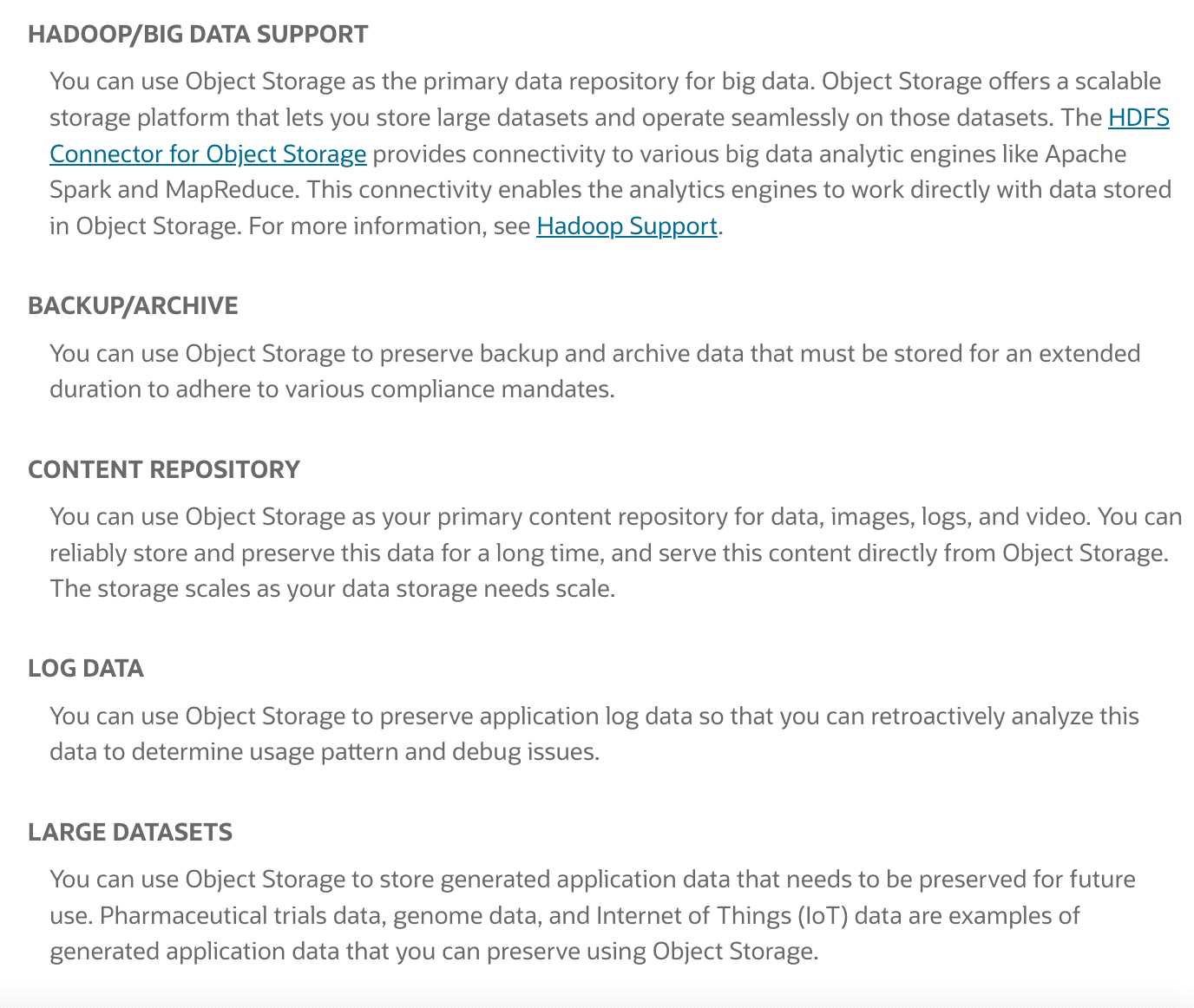
Reference:
https://docs.cloud.oracle.com/en-
us/iaas/Content/Object/Concepts/objectstorageoverview.htm
Question 9
Which Oracle Cloud Infrastructure (OCI) service is best suited for running serverless apps?
- A. Network Security Group
- A. Oracle Functions
- B. Web Application Firewall
- B. Virtual Cloud Network
- C. File Storage Service
- C. Streaming
- D. Security Lists
- D. Audit
Answer:
A
Explanation:
Oracle Functionsis a fully managed, multi-tenant, highly scalable, on-demand, Functions-as-a-
Service platform. It is built on enterprise-grade Oracle Cloud Infrastructure and powered by the Fn
Project open source engine. Use Oracle Functions (sometimes abbreviated to just Functions) when
you want to focus on writing code to meet business needs.
The serverless and elastic architecture of Oracle Functions means there's no infrastructure
administration or software administration for you to perform. You don't provision or maintain
compute instances, and operating system software patches and upgrades are applied automatically.
Oracle Functions simply ensures your app is highly-available, scalable, secure, and monitored. With
Oracle Functions, you can write code in Java, Python, Node, Go, and Ruby (and for advanced use
cases, bring your own Dockerfile, and Graal VM). You can then deploy your code, call it directly or
trigger it in response to events, and get billed only for the resources consumed during the execution.
Oracle Functions is based on Fn Project. Fn Project is an open source, container native, serverless
platform that can be run anywhere - any cloud or on-premises. Fn Project is easy to use, extensible,
and performant. You can download and install the open source distribution of Fn Project, develop
and test a function locally, and then use the same tooling to deploy that function to Oracle Functions.
You can access Oracle Functions using the Console, a CLI, and a REST API. You can invoke the
functions you deploy to Oracle Functions using the CLI or by making signed HTTP requests.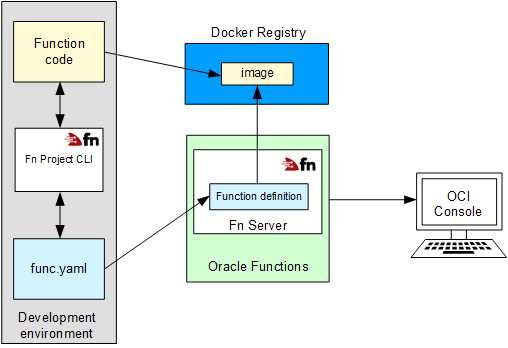
Reference:
https://docs.cloud.oracle.com/en-
us/iaas/Content/Functions/Concepts/functionsoverview.htm
Question 10
What does compute instance horizonal scaling mean?
- A. File Storage
- A. stopping/starting the instance
- B. Archive Storage
- B. backing up data to object storage
- C. Object Storage
- C. adding additional compute instances
- D. Block Volume
- D. changing compute instance size
Answer:
C
Explanation:
Cloud Horizontal Scalingrefers to provisioning additional servers to meet your needs, often splitting
workloads between servers to limit the number of requests any individual server is getting. In a
cloud-based environment, this would mean adding additional instances instead of moving to a larger
instance size.
Cloud Vertical Scalingrefers to adding more CPU or memory to an existing server, or replacing one
server with a more powerful server.
Reference:
https://cloudcheckr.com/cloud-cost-management/cloud-vs-data-center-what-is-scalability-in-cloud-
computing/
Horizontal scaling means that you scale by adding more machinesinto your pool of resources
whereasVertical scaling means that you scale by adding more power (CPU, RAM) to an existing
machine.
An easy way to remember this is to think of a machine on a server rack, we add more machines
across thehorizontaldirection and add more resources to a machine in theverticaldirection.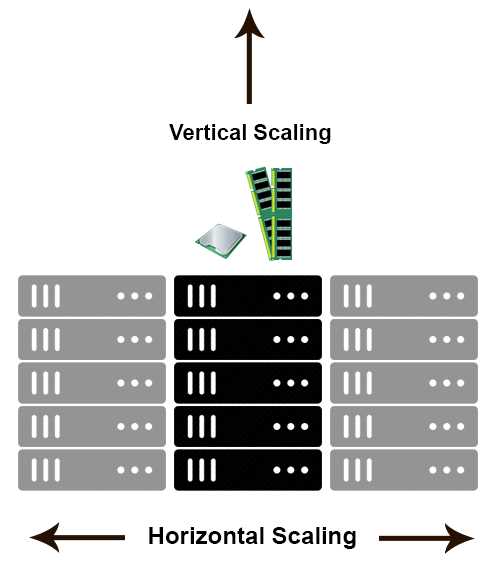
With horizontal-scaling it is often easier to scale dynamically by adding more machines into the
existing pool Vertical-scaling is often limited to the capacity of a single machine, scaling beyond
that capacity often involves downtime and comes with an upper limit.
Reference:
https://medium.com/@abhinavkorpal/scaling-horizontally-and-vertically-for-databases-
a2aef778610c
Question 11
OCI budgets can be set on which two options?
- A. federation
- A. Cost-tracking tags
- B. User Credential
- B. Free-form tags
- C. Network SecurityGroup
- C. Compartments
- D. Policies
- D. Virtual Cloud Network
- E. Tenancy
Answer:
A, C
Explanation:
In OCI a budget can be used to set soft limits on your Oracle Cloud Infrastructure spending. You can
set alerts on your budget to let you know when you might exceed your budget, and you can view all
of your budgets and spending from one single place in the Oracle Cloud Infrastructure console.
Budgets are set on
Cost-tracking tags
Compartments (including the root compartment)
Reference:
https://docs.cloud.oracle.com/en-us/iaas/Content/Billing/Concepts/budgetsoverview.htm
Question 12
you are analyzing your Oracle Cloud Infrastructure (OCI) usage with Cost Analysis tool in OCI Console.
Which is not a default feature of the tool?
- A. Only the dedicated virtual machine host will be billed
- A. Filter costs by applications
- B. The dedicated virtual machine host and the boot volumes of each instance will be billed
- B. Filter costs by compartments
- C. The dedicated virtual machine host all 5 instances, and the boot volume of each instance will be billed
- C. Filter costs by tags
- D. All 5 instances will be billed on the basis of the number of OCPUs
- D. Filter costs by date
Answer:
A
Explanation:
You can filter Costs Analysis Tools by following three ways
To filter costs by dates
To filter costs by tags
To filter costs by compartments
Reference:
https://www.oracle.com/a/ocom/docs/cloud/ops-billing-100.pdf
Question 13
Which OCI Identity and access management capability helps you to organize multiple users into
teams?
- A. Faster go-to market
- A. Policies
- B. Capital Expenditure to Operational Expenditure conversion
- B. Groups
- C. Greater agility
- C. Dynamic Groups
- D. Increased Total Cost of Ownership (TCO)
- D. Users
Answer:
B
Explanation:
IAMGroupis A collection of users who all need the same type of access to a particular set of
resources or compartment.
IAMDYNAMIC GROUPis A special type of group that contains resources (such as compute instances)
that match rules that you define (thus the membership can change dynamically as matching
resources are created or deleted). These instances act as "principal" actors and can make API calls to
services according to policies that you write for the dynamic group.
Reference:
https://docs.cloud.oracle.com/en-us/iaas/Content/Identity/Concepts/overview.htm
GROUP:
A collection of users who all need the same type of access to a particular set of resources or
compartment.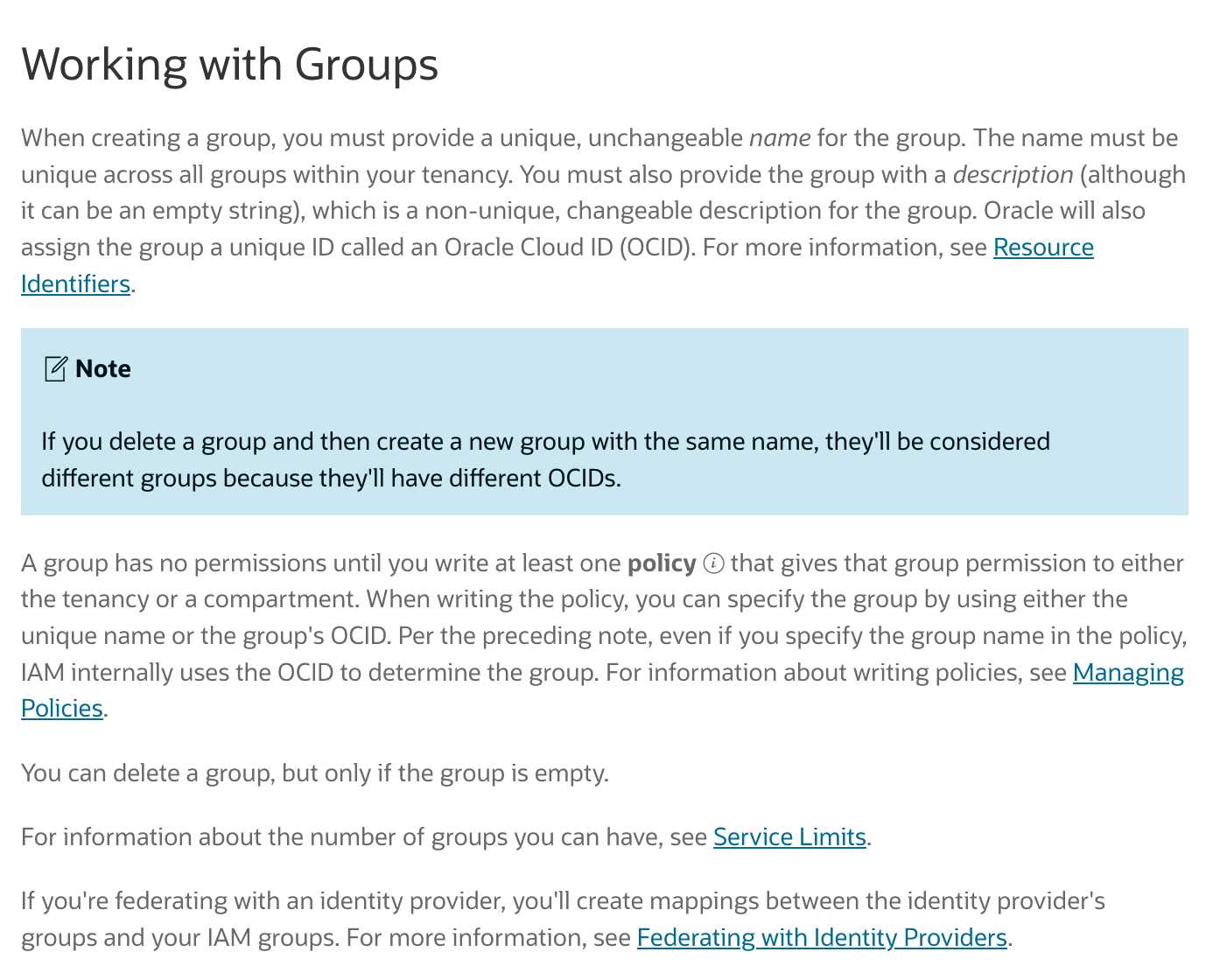
Reference:
https://docs.cloud.oracle.com/en-us/iaas/Content/Identity/Tasks/managinggroups.htm
Question 14
What is the frequency of OCI usage report generation?
- A. Add or change a tenancy administrator
- A. Weekly
- B. Request a Service Limit increase
- B. Monthly
- C. Reset the password or unlock the account for the tenancy administrator
- C. Annually
- D. Troubleshoot your resources in an Oracle Cloud Infrastructure Free Trial account
- D. Daily
Answer:
D
Explanation:
A usage report is a comma-separated value (CSV) file that can be used to get a detailed breakdown of
resources in Oracle Cloud Infrastructure for audit or invoice reconciliation.
The usage report is automatically generated daily, and is stored in an Oracle-owned Object Storage
bucket. It contains one row per each Oracle Cloud Infrastructure resource (such as instance, Object
Storage bucket, VNIC) per hour along with consumption information, metadata, and tags. Usage
reports generally contain 24 hours of usage data, although occasionally a usage report may contain
late-arriving data that is older than 24 hours.
Usage reports are retained for one year.
Reference:
https://docs.cloud.oracle.com/en-us/iaas/Content/Billing/Concepts/billingoverview.htm
https://docs.cloud.oracle.com/en-us/iaas/Content/Billing/Concepts/usagereportsoverview.htm
Question 15
Which service is the most effective for moving large amounts of data from your on-premises to OCI?
- A. OCI Autonomous Data Warehouse
- A. Data Transfer appliance
- B. OCI Virtual Machine Instance
- B. Data Safe
- C. OCI Dedicated Virtual Host
- C. Internal Gateway
- D. OCI Autonomous Transaction Processing
- D. Dynamic Routing Gateway
Answer:
A